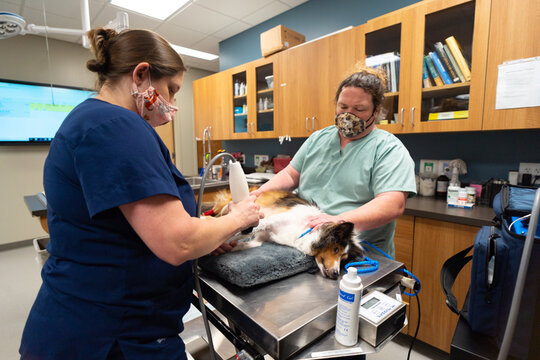Orthopedic Surgery Patients
These are likely to be the most frequent utilizers of our rehabilitation services, as orthopedic conditions are frequently seen in veterinary medicine. The most common disease process is rupture of the cranial cruciate ligament, which may be treated with a tibial plateau leveling osteotomy, tibial tuberosity advancement, extracapsular suture placement, or through conservative management. Other patients may have hip dysplasia treated with a femoral head ostectomy, total hip replacement, triple pelvic osteotomy, or through conservative management. Many patients also present with fractures of the long bones, which are mostly managed with internal fixation, but may also have external fixation or a rigid splint. Early return to function and weight bearing gives a much better long term prognosis to these patients. We usually see these patients starting 10-14 days after surgery to evaluate their pain and mobility, and help to slowly add in flexibility and strengthening exercises. Most patients graduate from rehabilitation 12 – 16 weeks after surgery depending on the type of surgery and other concurrent condition.

Neurologic Dysfunction Patients
This is the best way to train the muscles for basic functions like standing and sitting, and more advanced exercise like agility or running. Exercise addresses the strength of muscles, but also the coordination of muscles to perform a movement smoothly. Specific exercises are prescribed for pets depending on any functional problems at home, the nature of their injury, illness, or surgery, areas of weakness, and goals. Not all exercises are good for each patient, which is why it is important to follow an individualized therapeutic exercise program. After each assessment, clients go home with a detailed and individualized home exercise program for their pet.
Senior Patients
As patients age, they often develop multiple problems that contribute to weakness and pain. They may have osteoarthritis in multiple joints with accompanied muscle atrophy, as well as mild neurologic deficits or systemic causes for weakness or fatigue. Additionally chronic causes of pain can be difficult to manage with medications alone; medications can also have side effects on vital organs. A rehabilitative approach to these patients often gives them a better quality of life, with a focus on additional ways to manage pain and to build lost muscle mass. While traditional medicine focuses on treating underlying disease processes, rehabilitation focuses on correcting functional deficits, which is often more appropriate in geriatric patients. Using specific exercises to build lost muscle and keep our older dogs strong also has a protective effect on painful or unstable joints.
Canine Athletes
The increasing popularity of canine athletic competitions, like agility, flyball, and dock diving, has lead to athletes with previously unseen soft tissue injuries. These strains and sprains are not easily diagnosed with imaging modalities like radiographs, yet often are a severe limitation for competition, and even for comfort in the normal course of their day. Examination to specifically isolate muscles and tendons to palpate for abnormalities or pain, along with rehabilitation to increase range of motion and flexibility, are needed for these athletes to return to competition. Human athletes rely on physical therapists; canine athletes need rehabilitation medicine to compete at their full potential. Rehabilitation can devise a specific plan of exercise to return to full function, while protecting the previously injured area, and encouraging appropriate healing in soft tissues so ligaments and tendons stay strong.
